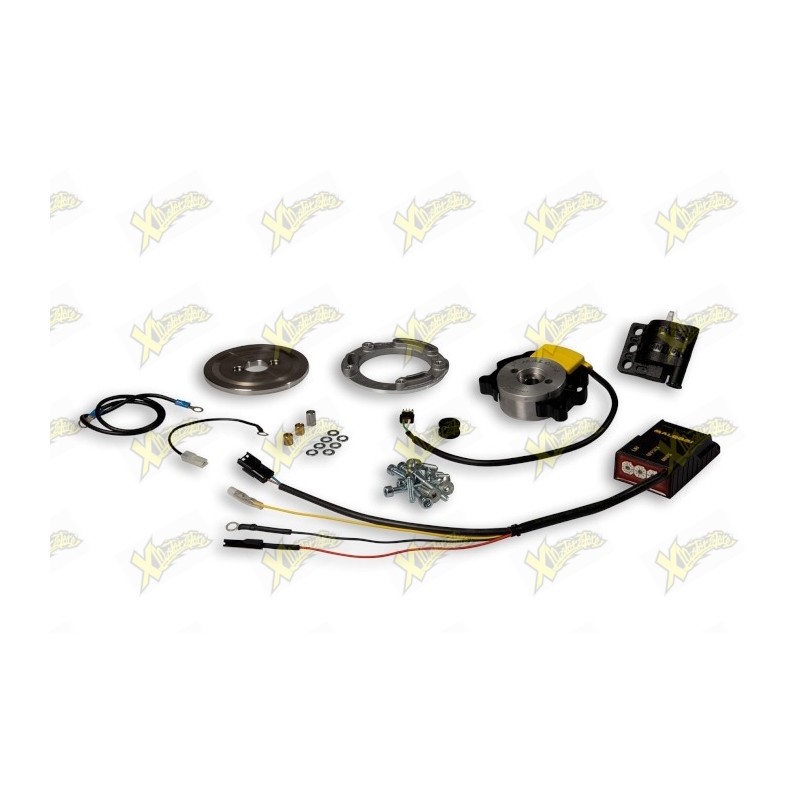- Reduced price
- New

Xmotorstore Payments



Malossi ignition for Minarelli AM6 50cc 2t. Malossi Code: 5519631
It manages multiple maps at the same time without having to resort to PDAs, with a simple click. It allows you to translate the selected map by moving the OFFSET (+ or - 2 °).
Malossi ignitions concentrate in themselves the maximum of technology applied to competitions. The new internal rotor ignitions arise from the need to overcome the technical limitations of the original flywheel-ignition groups, which above 10,000 rpm do not guarantee a constant performance, causing considerable and sometimes insurmountable tuning problems.
We have made the control unit even more immune to disturbances, developing a microprocessor based on uP STM8 - 8 Bit with higher computing capacity @ 20 MIPS to guarantee a much higher spark accuracy than the previous version!
The MHR Team II range is equipped with a non-remappable variable advance control unit with 3 trimmers: the first (MAPS) to determine the selection of the advance map
the second (OFFSET) allows you to move the selected map + or - 2 ° the third (LIM) indicated especially for 4-stroke engines, allows you to vary the intervention of the rev limiter (from 11,500 to 14,300 Rpm + limiter excluded )
It is also equipped with 8 preset mappings which are divided into:
1 for 4T variable advance engines
6 for 2-stroke engines with variable advance
1 with fixed advance
The other key components have also been revised such as the high voltage coil, now capable of delivering a maximum discharge voltage> 40 KV for normal engine speeds from> 3000 RPM and an extraordinary rise time @ 10bar> 1750 V / uS.
One of the most important innovations is the new rotor-stator group, whose static component has been completely redesigned from a mechanical and electronic point of view!
In the assembly instructions all the graphics will be provided in order to best set the advances on the different engines.
Electrical efficiency improved by 20%. Reduction of the minimum starting speed from 450 rpm to 370 rpm.
The effects of this latest evolution translate into an increase in the voltage delivered to the spark plug, with the same rotation speed, of anything but negligible significance compared to the previous model.
Malossi ignition for Minarelli AM6 50cc 2t. Malossi Code: 5519631
It manages multiple maps at the same time without having to resort to PDAs, with a simple click. It allows you to translate the selected map by moving the OFFSET (+ or - 2 °).
Malossi ignitions concentrate in themselves the maximum of technology applied to competitions. The new internal rotor ignitions arise from the need to overcome the technical limitations of the original flywheel-ignition groups, which above 10,000 rpm do not guarantee a constant performance, causing considerable and sometimes insurmountable tuning problems.
We have made the control unit even more immune to disturbances, developing a microprocessor based on uP STM8 - 8 Bit with higher computing capacity @ 20 MIPS to guarantee a much higher spark accuracy than the previous version!
The MHR Team II range is equipped with a non-remappable variable advance control unit with 3 trimmers: the first (MAPS) to determine the selection of the advance map
the second (OFFSET) allows you to move the selected map + or - 2 ° the third (LIM) indicated especially for 4-stroke engines, allows you to vary the intervention of the rev limiter (from 11,500 to 14,300 Rpm + limiter excluded )
It is also equipped with 8 preset mappings which are divided into:
1 for 4T variable advance engines
6 for 2-stroke engines with variable advance
1 with fixed advance
The other key components have also been revised such as the high voltage coil, now capable of delivering a maximum discharge voltage> 40 KV for normal engine speeds from> 3000 RPM and an extraordinary rise time @ 10bar> 1750 V / uS.
One of the most important innovations is the new rotor-stator group, whose static component has been completely redesigned from a mechanical and electronic point of view!
In the assembly instructions all the graphics will be provided in order to best set the advances on the different engines.
Electrical efficiency improved by 20%. Reduction of the minimum starting speed from 450 rpm to 370 rpm.
The effects of this latest evolution translate into an increase in the voltage delivered to the spark plug, with the same rotation speed, of anything but negligible significance compared to the previous model.
Reference: 5519640
Brand: Malossi
Malossi high voltage coil 5519640
Reference: 5517976B
Brand: Malossi
Malossi Digitronic Mhr code 5517976B digital electronic control unit Malossi digital electronic control unit Digitronic Mhr Team with Trimmer.
Reference: 5518085B
Brand: Malossi
Malossi rotor and stator assembly 5518085B Code: 5518085B Malossi rotor and stator assembly for moto 50, diameter 58 mm
Reference: 5515740
Brand: Malossi
Malossi 5515740 strobe controller Code: 5515740 This small-sized instrument not only allows the advance to be checked with disarming ease, thanks to a 200 lm flash with a duration of 10 µs and an extremely short delay (<1µs), but it also completely replaces the classic strobe guns, thanks to the its technical characteristics decidedly superior to many...
Reference: 5517650
Brand: Malossi
Malossi inertia flywheel 5517650 Code: 5517650 Malossi inertia flywheel for internal rotor ignition Weight: 201 g
Reference: 5511551B
Brand: Malossi
Malossi flywheel 5511551B Code: 5511551B Malossi inertia flywheel for internal rotor ignition Weight: 296 g
Reference: 5519119B
Brand: Malossi
Shielded Malossi spark plug cap 5519119B Malossi code: 5519119B
Reference: 5519221
Brand: Malossi
Malossi spark plug cable and shielded spark plug cap kit 5519221 Malossi code: 5519221 Shielded spark plug connection - Spark plug connection equipped with a high quality resistor, which guarantees constant resistance with minimal variations in overload conditions. -External body made with a robust rubber structure characterized by excellent resistance to...
Reference: 01.SC.0046.L
Brand: Ohvale
Ohvale Silencer 190/212 Code: 01.SC.0046.L
Reference: 144.800.021
Brand: POLINI
Rear mudflap XP4 Code: 144.800.021 Polini minicross spare part
Reference: 248.120
Brand: POLINI
Polini variator belt for Piaggio 125/150 Leader Code: 248.120 Application: Aprilia, Aprilia Atlantic 125, Aprilia Arrefice, Aprilia Mojito 125 RY, Aprilia SR 125 MAX 4T i E3, Benelli, Benelli Adiva 125/150, Derbi, Derbi Boulevard 125/150, Derbi Gp1, Gilera, Gilera Dna 125 4T, Gilera Runner 125 VX 4T, Gilera Nexus 125, Italjet, Italjet Jet set 125/150,...
Reference: 53 7626
Brand: Malossi
Malossi complete connecting rod 53 7626 Malossi code: 53 7626 Malossi complete connecting rod with 12 mm diameter pin.
Reference: 5216524
Brand: Malossi
Clutch disc set 6 springs Mhr Malossi 5216524 Malossi code: 5216524
Reference: 6215045BB
Brand: Malossi
Malossi approved brake pads Malossi code: 6215045BB Malossi brake pads for CAGIVA CITY 50 2T Front for vehicles PRODUCED 1992-1994 APPROVED. Malossi brake pads for HONDA DIO G 50 2T (AF18E) Front for vehicles PRODUCED 1991 APPROVED. Malossi brake pads for HONDA DIO SP 50 2T (AF18E) Front for vehicles PRODUCED 1993 APPROVED. Malossi brake pads for HONDA...
Reference: 01.RA.0023.L
Brand: Ohvale
Front wheel Ohvale bearing till 2020 Code: 01.RA.0023.L
Reference: 140.0183/R
Brand: POLINI
Polini cylinder kit diameter 47 mm racing 140.0183 / R Polini thermal group kit for: Aprilia, Aprilia Sr 50 2T R, Aprilia Sr 50 2T Factory Lc, Aprilia Sr 50 Factory Lc E4, Derbi, Derbi GP1 50 euro2, Derbi GP1 50 Open, Derbi GP1 50 Race, Derbi GP1 50, Gilera , Gilera Dna 50, Gilera Runner 50, Gilera Runner 50 Sp, Gilera Runner 50 Poggiali, Piaggio, Piaggio...
Reference: 01.MO.0452.L
Brand: Ohvale
Ohvale Piston 212Code: 01.MO.0452.L
Reference: GHR035.003
Brand: GHR
Mini-bike clutch shoes GHR 2 masses 2G G-Carbotech. Massette for minimoto clutch, compatible with: Ghr, Cs, Tcm, Bzm, Polini. The GHR masses are suitable for racing use, perfect for short and long slopes, compatible with engines: Bzm, Iame, Cs, Tcm, Ghr. We recommend using an 81mm bell for running-in, and an 80mm bell for use.
Reference: 4613182
Brand: Malossi
Malossi Twins rear shock absorber 4613182 Malossi code: 4613182 Malossi Twins rear shock absorber.
Reference: 200.0415
Brand: POLINI
Polini exhaust for Hm Baja Cre Derapage 50 cc. Polini Code: 200.0415. Muffler compatible with HM: CRE 50, DERAPAGE 2007/2012 (50X, 50R) VENT: DERAPAGE 50 Minarelli AM6 Euro4 / 5 - BAJA 50 Minarelli AM6 Euro4 / 5 BETA: RR 50 2T Euro 4 They are exhaust systems intended for the after market designed and developed for characteristics of liquid-cooled engines.
Reference: 01.OT.0339.L
Brand: Ohvale
Ohvale Screw TCEI M6X55 160 4S Code: 01.OT.0339.L
Reference: 280.0040
Brand: POLINI
Crankcase bearing Ciao-Si 15X35X11 C4 Code: 280.0040 Application: Piaggio, Piaggio Boxer, Piaggio Bravo, Piaggio Cba, Piaggio Ciao, Piaggio Eco, Piaggio Grillo, Piaggio Si, Piaggio Trend, Polini, Gilera, Gilera Cba
Reference: 01.SD.0104.L
Brand: Ohvale
Ohvale Bolt hexagon flange M6x25Code: 01.SD.0104.L
Reference: 271.0002
Brand: POLINI
Polini plug diameter 12X37X8 mm. Polini code: 271.0002 12X37X8 mm plug compatible with all types of motorcycles

Malossi ignition for Minarelli AM6 50cc 2t. Malossi Code: 5519631
It manages multiple maps at the same time without having to resort to PDAs, with a simple click. It allows you to translate the selected map by moving the OFFSET (+ or - 2 °).
Malossi ignitions concentrate in themselves the maximum of technology applied to competitions. The new internal rotor ignitions arise from the need to overcome the technical limitations of the original flywheel-ignition groups, which above 10,000 rpm do not guarantee a constant performance, causing considerable and sometimes insurmountable tuning problems.
We have made the control unit even more immune to disturbances, developing a microprocessor based on uP STM8 - 8 Bit with higher computing capacity @ 20 MIPS to guarantee a much higher spark accuracy than the previous version!
The MHR Team II range is equipped with a non-remappable variable advance control unit with 3 trimmers: the first (MAPS) to determine the selection of the advance map
the second (OFFSET) allows you to move the selected map + or - 2 ° the third (LIM) indicated especially for 4-stroke engines, allows you to vary the intervention of the rev limiter (from 11,500 to 14,300 Rpm + limiter excluded )
It is also equipped with 8 preset mappings which are divided into:
1 for 4T variable advance engines
6 for 2-stroke engines with variable advance
1 with fixed advance
The other key components have also been revised such as the high voltage coil, now capable of delivering a maximum discharge voltage> 40 KV for normal engine speeds from> 3000 RPM and an extraordinary rise time @ 10bar> 1750 V / uS.
One of the most important innovations is the new rotor-stator group, whose static component has been completely redesigned from a mechanical and electronic point of view!
In the assembly instructions all the graphics will be provided in order to best set the advances on the different engines.
Electrical efficiency improved by 20%. Reduction of the minimum starting speed from 450 rpm to 370 rpm.
The effects of this latest evolution translate into an increase in the voltage delivered to the spark plug, with the same rotation speed, of anything but negligible significance compared to the previous model.